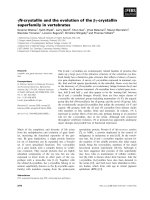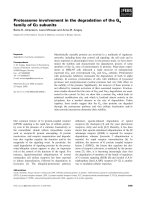Bài báo khoa học: Valve repair improves the outcome of surgery for mitral regurgitation: a multivariate analysis
Bạn đang xem bản rút gọn của tài liệu. Xem và tải ngay bản đầy đủ của tài liệu tại đây (372.23 KB, 12 trang )
Valve Repair Improves the Outcome of
Surgery for Mitral Regurgitation
A Multivariate Analysis
Maurice Enriquez-Sarano, Hartzell V. Schaff, Thomas A. Orszulak, A. Jamil
Tajik, Kent R. Bailey, Robert L. Frye
/>Circulation. 1995;91:1022-1028
Originally published February 15, 1995
Article
Figures & Tables
Info & Metrics
eLetters
Abstract
Background Mitral valve repair has been suggested as providing a better
postoperative outcome than valve replacement for mitral regurgitation, but this
impression has been obscured by differences in baseline characteristics and has not
been confirmed in multivariate analyses.
Methods and Results The outcomes in 195 patients with valve repair and 214 with
replacement for organic mitral regurgitation were compared using multivariate
analysis. All patients had preoperative echocardiographic assessment of left
ventricular function. Before surgery, patients with valve repair were less symptomatic
than those with replacement (42% in New York Heart Association functional class I
or II versus 24%, respectively; P=.001), had less atrial fibrillation (41% versus
53%; P=.017), and had a better ejection fraction (63±9% versus 60±12%, P=.016).
After valve repair, compared with valve replacement, overall survival at 10 years was
68±6% versus 52±4% (P=.0004), overall operative mortality was 2.6% versus 10.3%
(P=.002), operative mortality in patients under age 75 was 1.3% versus 5.7%
(P=.036), and late survival (in operative survivors) at 10 years was 69±6% versus
58±5% (P=.018). Late survival after valve repair was not different from expected
survival. After surgery, ejection fraction decreased significantly in both groups but
was higher after valve repair (P=.001). Multivariate analysis indicated an
independent beneficial effect of valve repair on overall survival (hazard ratio,
0.39; P=.00001), operative mortality (odds ratio, 0.27; P=.026), late survival (hazard
ratio, 0.44; P=.001), and postoperative ejection fraction (P=.001).
Conclusions Valve repair significantly improves postoperative outcome in patients
with mitral regurgitation and should be the preferred mode of surgical correction. The
low operative mortality is an incentive for early surgery before ventricular dysfunction
occurs.
mitral
valve
prognosis
ventricles
myocardium
surgery
Since the early days of cardiac surgery,1 2 3 4 the repair of regurgitant mitral valves
has been pioneered with the perception that maintaining the normal architecture of
the mitral valve is beneficial to the patient.5 However, the clinical suggestion that
valve repair, compared with valve replacement, improves postoperative
survival6 7 8 9 10 11 and left ventricular function1213 14 has been obscured by
differences in baseline characteristics among the patients treated by the two
methods14 15 16 17 and has not been confirmed by multivariate analysis.15 16Moreover,
comparison between repair and replacement has been hindered by the limited
number of repairs involved15 16 and by the failure to consider important predictors of
outcome such as preoperative left ventricular function.18 19 20 Thus, the clinical
impact of valve repair has remained uncertain as has, therefore, its potential as the
preferred surgical method of correction of mitral regurgitation. Accordingly, we
examined the outcome after valve repair and valve replacement in patients with
mitral regurgitation in whom preoperative left ventricular function could be assessed
echocardiographically, having hypothesized that mitral valve repair improves
operative mortality, late survival, and postoperative residual left ventricular function
compared with mitral valve replacement.
Methods
The present study was based on a review of our experience with valve repair and
valve replacement for the surgical correction of mitral regurgitation.
Included in the study were patients who had repair or replacement of the mitral valve
performed between January 1, 1980, and December 31, 1989; who had acquired
organic mitral regurgitatio������������������������������������������������������������������������������������������������������������������������������������������������������������������������������������������������������������������������������������������������������������������������������������������������������������������������������������������������������������������������������������������������������������������������������������������������������������������������������������������������������������������������������������������������������������������������������������������������������������������������������������������������������������������������������������������������������������������������������������������������������������������������������������������������������������������������������������������������������������������������������������������������������������������������������������������������������������������������������������������������������������������������������������������������������������������������������������������������������������������������������������������������������������������������������������������������������������������������������������������������������������������������������������������������������������������������������������������������������������������������������������������������������������������������������������������������������������������������������������������������������������������������������������������������������������������������������������������������������������������������������������������������������������������������������������������������������������������������������������������������������������������������������������������������������������������������������������������������������������������������������������������������������������������������������������������������������������������������������������������������������������������������������������������������������������������������������������������������������������������������������������������������������������������������������������������������������������������������������������������������������������������������������������������������������������������������������������������������������������������������������������������������������������������������������������������������������������������������������������������������������������������������������������������������������������������������������������������������������������������������������������������������������������������������������������������������������������������������������������������������������������������������������������������������������������������������������������������������������������������������������������������������������������������������������������������������������������������������������������������������������������������������������������������������������������������������������������������������������������������������������������������������������������������������������������������������������������������������������������������������������������������������������������������������������������������������������������������������������������������������������������������������������������������������������������������������������������������������������������������������������������������������������������������������������������������������������������������������������������������������������������������������������������������������������������������������������������������������������������������������������������������������������������������������������������������������������������������������������������������������������������������������������������������������������������������������������������������������������������������������������������������������������������������������������������������������������������������������������������������������������������������������������������������������������������������������������������������������������������������������������������������������������������������������������������������������������������������������������������������������������������������������������������������������������������������������������������������������������������������������������������������������������������������������������������������������������������������������������������������������������������������������������������������������������������������������������������������������������������������������������������������������������������������������������������������������������������������������������������������������������������������������������������������������������������������������������������������������������������������������������������������������������������������������������������������������������������������������������������������������������������������������������������������������������������������������������������������������������������������������������������������������������������������������������������������������������������������������������������������������������������������������������������������������������������������������������������������������������������������������������������������������������������������������������������������������������������������������������������������������������������������������������������������������������������������������������������������������������������������������������������������������������������������������������������������������������������������������������������������������������������������������������������������������������������������������������������������������������������������������������������������������������������������������������������������������������������������������������������������������������������������������������������������������������������������������������������������������������������������������������������������������������������������������������������������������������������������������������������������������������������������������������������������������������������������������������������������������������������������������������������������������������������������������������������������������������������������������������������������������������������������������������������������������������������������������������������������������������������������������������������������������������������������������������������������������������������������������������������������������������������������������������������������������������������������������������������������������������������������������������������������������������������������������������������������������������������������������������������������������������������������������������������������������������������������������������������������������������������������������������������������������������������������������������������������������������������������������������������������������������������������������������������������������������������������������������������������������������������������������������������������������������������������������������������������������������������������������������������������������������������������������������������������������������������������������������������������������������������������������������������������������������������������������������������������������������������������������������������������������������������������������������������������������������������������������������������������������������������������������������������������������������������������������������������������������������������������������������������������������������������������������������������������������������������������������������������������������������������������������������������������������������������������������������������������������������������������������������������������������������������������������������������������������������������������������������������������������������������������������������������������������������������������������������������������������������������������������������������������������������������������������������������������������������������������������������������������������������������������������������������������������������������������������������������������������������������������������������������������������������������������������������������������������������������������������������������������������������������������������������������������������������������������������������������������������������������������������������������������������������������������������������������������������������������������������������������������������������������������������������������������������������������������������������������������������������������������������������������������������������������������������������������������������������������������������������������������������������������������������������������������������������������������������������������������������������������������������������������������������������������������������������������������������������������������������������������������������������������������������������������������������������������������������������������������������������������������������������������������������������������������������������������������������������������������������������������������������������������������������������������������������������������������������������������������������������������������������������������������������������������������������������������������������������������������������������������������������������������������������������������������������������������������������������������������������������������������������������������������������������������������������������������������������������������������������������������������������������������������������������������������������������������������������������������������������������������������������������������������������������������������������������������������������������������������������������������������������������������������������������������������������������������������������������������������������������������������������������������������������������������������������������������������������������������������������������������������������������������������������������������������������������������������������������������������������������������������������������������������������������������������������������������������������������������������������������������������������������������������������������������������������������������������������������������������������������������������������������������������������������������������������������������������������������������������������������������������������������������������������������������������������������������������������������������������������������������������������������������������������������������������������������������������������������������������������������������������������������������������������������������������������������������������������������������������������������������������������������������������������������������������������������������������������������������������������������������������������������������������������������������������������������������������������������������������������������������������������������������������������������������������������������������������������������������������������������������������������������������������������������������������������������������������������������������������������������������������������������������������������������������������������������������������������������������������������������������������������������������������������������������������������������������������������������������������������������������������������������������������������������������������������������������������������������������������������������������������������������������������������������������������������������������������������repair and replacement groups. No
significant difference is observed.
Discussion
In the present series of 195 valve repairs and 214 valve replacements performed for
organic mitral regurgitation, there are differences in baseline characteristics between
the two groups, but multivariate analysis confirms that valve repair is an independent
determinant of improved operative and late survival and of improved left ventricular
function.
Beneficial Results of Valve Repair Compared With Valve Replacement
In patients with mitral stenosis, conservative surgery—that is, commissurotomy—
provides both low operative risk and excellent late survival, with a low incidence of
valve-related complications.28 These results are at variance with those obtained with
valve replacement.29Thus, in this setting, conservative surgery, if feasible, has
always been the preferred option. Conservative surgery (valve repair) has also been
attempted for mitral regurgitation since the early days of cardiac surgery, 1 2 3 4 but
the results have been more inconsistent30 31 32 33because the lesions of mitral
regurgitation are more complex and difficult to correct.34 The techniques of repair of
regurgitant lesions have progressively improved,35 36 and with the decrease in
rheumatic valve disease37 they are now widely applied in the large population with
degenerative mitral valve disease.10 37 38 39 40 The durability of valve repair also has
been well demonstrated.41 42 43
However, valve repair can be difficult,44 and its superiority to prosthetic replacement
has not been firmly established15 16 44 45 because of small sample sizes45 and of
differences in baseline characteristics of patients14 15 16 17 that suggest that surgery
was performed at an earlier stage in valve repair than in valve replacement. It has
remained uncertain, therefore, whether the observed differences in outcome are
related to the method of correction of the mitral regurgitation or to a more favorable
clinical situation existing before surgery. Matching identical patients who have had
either valve repair or replacement has been attempted,19 45but this method is
selective and has its drawbacks. Thus, the best way of addressing the issue of
nonuniformity of the groups is to perform multivariate analyses that include the most
important prognostic indicators. When this type of analysis was performed in other
studies, however, it did not show a significant independent prognostic impact of
valve repair.15 16 In contrast, the present study demonstrates that the method of
correction is indeed an independent determinant of the observed differences in
survival after valve repair in comparison with valve replacement. The large number
of repairs, the homogeneity of the patient population, and the preoperative
assessment of left ventricular function probably contribute to the statistical power of
the present series.
Mechanism of Improved Outcome
The lower operative mortality after valve repair in the present study is consistent with
previous observations,9 but the mechanism has not been fully understood. However,
since left ventricular dysfunction is the major cause of late death after mitral valve
surgery,46 the lower mortality rate in patients with valve repair is readily
understandable: after valve repair, postoperative ejection fraction is significantly
higher than after valve replacement, and the incidence of death due to left ventricular
dysfunction is reduced. Although this phenomenon is in part related to a better
preoperative function, it also is an intrinsic effect of valve repair. Improvement in left
ventricular function was previously suggested, mainly on the basis of small
series,13 14 but in the present study, postoperative echocardiograms were available
in 315 of the 409 patients to conclusively confirm this improvement.
The role of the conservation of the normal mitral apparatus architecture in the
preservation of left ventricular function has been underlined experimentally47 48 as
well as clinically,14 49 50 51even in association with mitral valve replacement. The
better postoperative left ventricular function is not related to a higher left ventricular
mass in patients with valve repair.52 Instead, it has been suggested that the
geometry of the left ventricle is more favorable25 in association with conservation of
the mitral architecture, leading to a reduction in wall stress that may allow more
favorable remodeling of the ventricle after correction of the regurgitation.
It is to be noted, however, that ejection fraction decreases after valve repair53 and
that the difference with valve replacement is only a matter of the magnitude of the
left ventricular response to surgery. Thus, the ability to perform valve repair should
not allow one to disregard a potential left ventricular dysfunction. This complication is
associated with poor postoperative prognosis18 19 46 and is not eradicated by
performance of valve repair. The prognostic value of the preoperative
echocardiographic ejection fraction is significant in patients with valve repair as well
as in those with valve replacement20 and should be taken into account in the clinical
decision-making process.
The improved outcome after valve repair is not obtained at the expense of an
increase in valve-related complications. In particular, the incidence of reoperation
does not significantly differ between valve repair and replacement. Furthermore, the
incidence of significant hemorrhage is decreased with valve repair, another feature
explaining the lower number of valve-related deaths.
New improvements should extend the field of application of mitral valve repair.
Artificial chordae and transposition of chordae35 36 are now available for flail anterior
leaflets, which were, until recently, more difficult to repair than flail posterior leaflets.
Also, the addition of intraoperative transesophageal echocardiography has made it
possible to detect, and immediately correct, unsatisfactory repairs.54 55
Potential Limitations
The use of echocardiography may raise concern. However, all the reported
measurements were directed by two-dimensional echocardiography, and the
assessment of ejection fraction by this methodology has not only been
validated23 24 but also has shown acceptable correlations to angiography in our
routine experience, and the high degree of reproducibility56and the value of the visual
estimate57 58 have been confirmed. Moreover, the most significant test of validity of a
technique resides in its prognostic power. In patients with mitral regurgitation,
echocardiographic ejection fraction is the most powerful predictor of postoperative
left ventricular function46 and survival.20 After surgery, the paradoxic septal motion
associated with cardiac surgery has been shown to be a translational
movement59rather than a regional wall motion abnormality, and it does not impair the
ability to assess postoperative left ventricular function by echocardiography.
Furthermore, the postoperative left ventricular function shows no systematic trend for
improvement or deterioration with time,46 and consequently the timing of
measurement of the postoperative ejection fraction does not have an impact on the
results and on the fact that postoperative left ventricular function is better preserved
after valve repair than after replacement. The fact that not all patients could have an
assessment of postoperative ejection fraction has been encountered even in
prospective studies,18 but these patients were similar to the patients without
postoperative echocardiograms and thus were representative of the overall
population in the present study.
The fact that baseline characteristics are different between the two groups of
patients may be considered a limitation but is the precise reason why the superiority
of valve repair over valve replacement remained uncertain.15 16 Because a
randomized trial has never been performed and may not be feasible, the only
presently acceptable method of comparison of the two surgical procedures is to
adjust for the baseline outcome predictors in multivariate analysis, as was performed
in the present study.
Clinical Implications
The present series of 195 valve repairs and 214 valve replacements shows that after
adjustment for all confounding variables, valve repair is a strong independent
predictor of improved survival and postoperative left ventricular function, without
compromise of the valvular results, in comparison with valve replacement. These
data suggest that valve repair should be the preferred method of correction of mitral
regurgitation and should be considered in all cases in which surgery is contemplated.
The low operative risk of valve repair is an incentive to consider surgery at an early
stage in the course of the disease before the advent of left ventricular dysfunction.
Acknowledgments
We acknowledge the expert secretarial assistance of Janet L. Halling, the data
abstracting of Kim D. Jones, and the data analysis of Sara L. Fett in the preparation
of this manuscript.
Footnotes
Reprint requests to Maurice Enriquez-Sarano, MD, Mayo Clinic, 200 First St
SW, Rochester, MN 55905.
Received May 11, 1994.
Revision received August 2, 1994.
Accepted September 13, 1994.
Copyright © 1995 by American Heart Association









